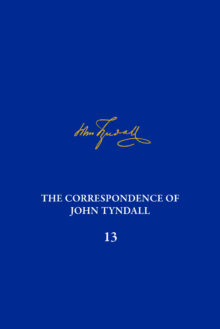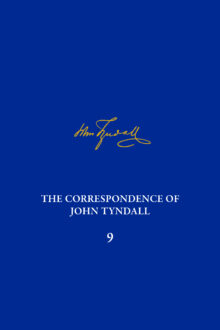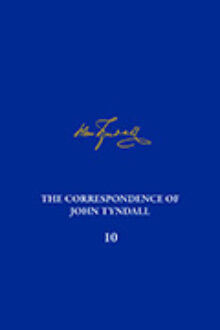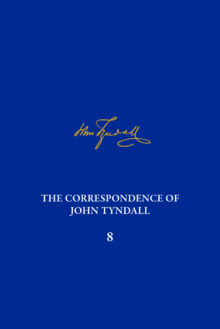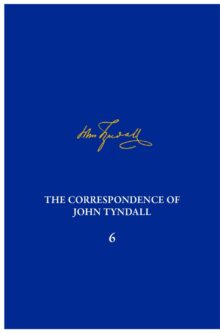
Michael D. Barton
Michael D. Barton is an independent historian.
The Correspondence of John Tyndall, Volume 13
The Correspondence, June 1872–September 1873
The 476 letters in the thirteenth volume of The Correspondence of John Tyndall document the period from June 1, 1872, to September 28, 1873, much of which was consumed by Tyndall’s lecture tour of the United States. We meet him in the midst of the Ayrton affair, which saw Tyndall coming to the defense of his friend and fellow X Club member Joseph Dalton Hooker against the First Commissioner of Works, Acton Smee Ayrton, in an acrimonious dispute over the governance of the Royal Botanic Gardens, Kew. Tyndall’s tour of the United States was a rousing success by many measures, but he was not long on American shores before his well-documented skepticism of the efficacy of prayer stoked the waspish ire of the faithful. Tyndall’s return to England in mid-February 1873 saw him begin preparations for his 1874 Belfast Address, when he accepted the presidency of the British Association for the Advancement of Scienceand articulated a defense of materialism that scandalized many of his contemporaries. As we leave him in September 1873, Tyndall is engaged in sharp-elbowed jostling with Scottish physicist Peter Guthrie Tait in the pages of Nature over James David Forbes, whose theory of glacial motion Tait had defended against Tyndall’s attacks, in a scientific disagreement that evolved into a personal one. Amid the tumult of controversy, though, these letters reveal a man of science riding high on widespread esteem, wielding the influence it brought him with gusto, and moving with ease through the rarefied social and intellectual circles into which he had climbed.
The Correspondence of John Tyndall, Volume 9
The Correspondence, February 1865—December 1866
This ninth volume of the Tyndall correspondence contains 314 letters. Tyndall was by now in his mid-forties and in the prime of life. His career as a man of science was firmly established and flourishing. He had been professor of natural philosophy at the Royal Institution for more than a dozen years. He had established himself as Michael Faraday’s successor, and during the intervening years had taken on an increasing number of Faraday’s wide range of duties. This volume also covers the period of Faraday’s increasing illness and withdrawal from public life, which had a significant impact on Tyndall both personally and in terms of his standing in the scientific world. Since Tyndall’s appointment at the RI in 1853, Faraday had been a mentor and a close personal friend. Despite their difference in age, politics, religion, and science, the two men clearly held each other in great affection. Correspondence between them is few in number in this volume, but letters from Tyndall to Faraday’s niece Jane Barnard make the affection clear.
The Correspondence of John Tyndall, Volume 10
The Correspondence, January 1867–December 1868
The tenth volume of The Correspondence of John Tyndall spans from January 1867 to December 1868. It begins with Tyndall publicly enmeshed in a controversy that revealed his views on race, politics, and justifiable violence. Further pressure is exerted on him personally by the death of his mother Sarah, and the numerous calls on him to support relatives in Ireland. Michael Faraday’s death in August 1867 adds to these demands, as Tyndall assumes Faraday’s responsibilities at the Royal Institution. In this period, Tyndall writes his popular book Sound, as well as Faraday as a Discoverer, his memorial to Faraday.
The Correspondence of John Tyndall, Volume 8
The Correspondence, June 1862-January 1865
The 318 letters in this volume reveal a great deal about Tyndall’s personality, the development of his career, and his role in attempting to better establish science as a respectable and professional enterprise. However, Tyndall was not above controversy, and on more than one occasion he entered public disputes either in defense of his own or a colleagues’ priority claims over scientific discoveries. Perhaps the most dramatic letters—if not those detailing the accounts of his cousin Hector Tyndale’s courageous exploits in the American Civil War—are those relating to Tyndall’s mountaineering adventures. He climbed in pursuit of science, and often with only a guide, making an attempt on the Matterhorn just days after Edward Whymper had failed in the effort. Toward the end of this volume, Tyndall, Thomas Henry Huxley, and others acquired the Reader. Although short-lived, the journal intended to promote and publish the works, society meetings, and correspondence of scientific men, and demonstrates Tyndall’s commitment to the popularization of science and to facilitating communication within the international scientific community.
The Correspondence of John Tyndall, Volume 6
The Correspondence, November 1856-February 1859
This sixth volume of Tyndall’s correspondence contains 302 letters covering a period of twenty-eight months (1856-1859). It begins shortly after Tyndall returned from his first glacier research in the Alps and follows him as he experimented and lectured on physics in central London at the Royal Institution of Great Britain (RI), visited friends, joined London’s fashionable social circles, published and reviewed scientific articles, corresponded with fellow men of science on a wide range of topics, and developed his theories about the structure and movement of glaciers. Importantly, volume 6 includes Tyndall’s major expeditions to the Alps and also documents some of his most dangerous mountaineering exploits. In letters to his closest friends, Tyndall captured the excitement and achievement of his expeditions. By the end of the period, his is increasingly respected as a scientist in the wider academic world.

